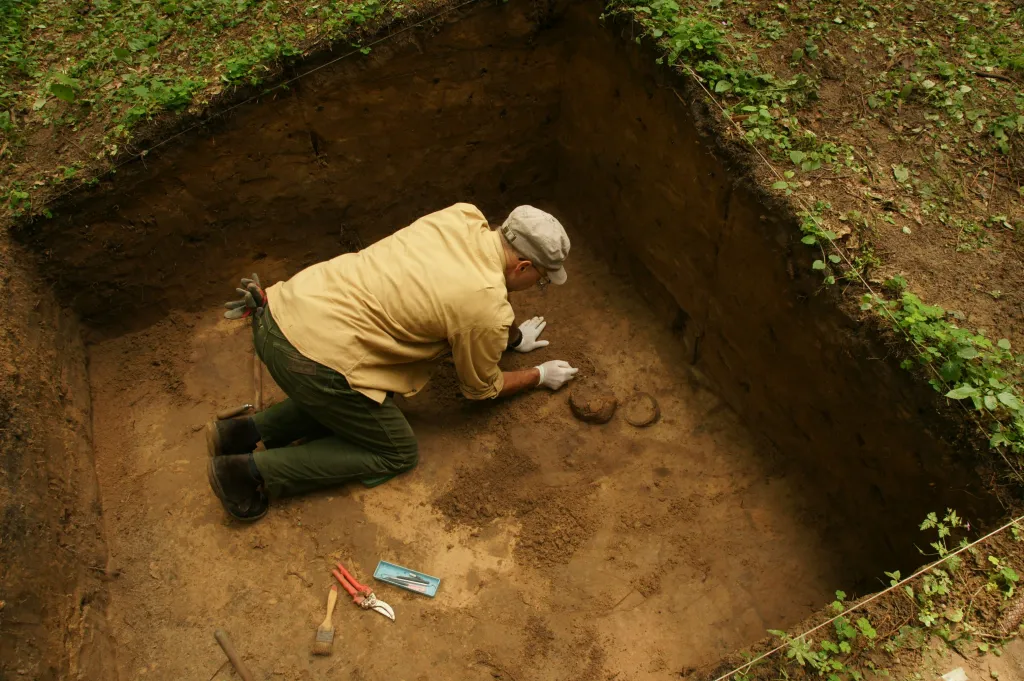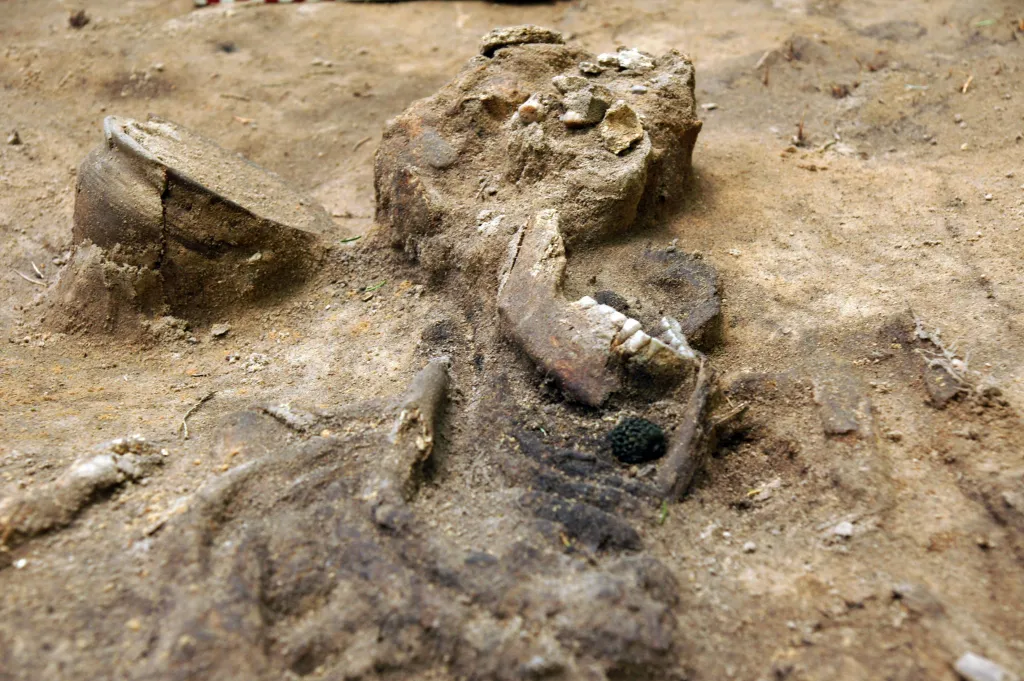
Most of the known barrows and other remains of ancient human activity in the Białowieża Forest were discovered in the 21st century. This was possible thanks to the use of new research methods, including laser scanning.
Consequently, the forest is no longer an archaeological 'blank spot', researchers say.
The Białowieża Forest is the last natural forest in the European Plain. A bison refuge and a place where wolves and lynxes can be found in natural surroundings, it is also an attraction for nature lovers. A part of the forest has the status of a national park. The forest is the only Polish natural site in the UNESCO World Heritage List.
Until now, the area of the Białowieża Forest has been poorly explored by archaeologists. For most of the 20th century, they discovered unknown archaeological sites mainly thanks to surface research, by searching for and collecting mainly fragments of clay vessels and flint tools. This was possible almost exclusively in cultivated fields, because forests and areas covered with dense vegetation effectively made this task difficult.
Dariusz Krasnodębski from of the Institute of Archaeology and Ethnology of the Polish Academy of Sciences in Warsaw said: “Until recently, the Białowieża Forest was one of the archaeologically least explored regions of north-eastern Poland. Until the beginning of the 21st century, only a few dozen archaeological sites from an area of nearly 620 km2, i.e. the entire Polish part, were listed in the official register.”
Researching the past of the Białowieża Forest together with his team for 20 years, Krasnodębski said that by the end of 2022, over 600 archaeological sites had been discovered. He is sure that there will be more.
The intensification of research by several teams of scientists in recent years has contributed to the discovery of hitherto unknown places of human activity, dating from prehistory to modern times. The increasingly popular remote sensing methods were also used, including airborne laser scanning which detects the terrain even if it is covered with vegetation.
In the recently published book Archeologia Puszczy Białowieskiej. Dzieje osadnictwa na terenie polskiej części Puszczy Białowieskiej od epoki kamienia do końca XVIII stulecia(Archaeology of the Białowieża Forest, the history of settlement in the Polish part of the Białowieża Forest from the Stone Age to the end of the 18th century, https://www.rcin.org.pl/dlibra/publication/273281/edition/237040) researchers from the Polish Academy of Sciences - Dariusz Krasnodębski and Hanna Olczak - collected and systematized the existing knowledge on the archaeology of the Białowieża Forest.
The publication was co-financed by the Ministry of Culture and National Heritage.
As we read in the book, it is a summary of 100 years of research conducted in this area by many teams of scientists, including those from the Institute of Archaeology and Ethnology PAS, the Cardinal Stefan Wyszyński University and State Forests.
Krasnodębski said: “We wanted it to be a work addressed to professionals, archaeologists and historians, as well as naturalists and readers who are simply interested in the past or are nature lovers who want to explore the beauty of the Białowieża Forest, including its archaeological layer.”
He added that the total number of over 600 archaeological sites includes both individual discoveries of flint or pottery artefacts, as well as barrow clusters. The largest of them are early medieval cemeteries in the Jelonka and Szczekotowo wildernesses, with about 100 mounds each.
Another category of remnants of human activity are low earth embankments, which - according to archaeologists - are most likely relics of prehistoric land divisions. They were probably crofts or animal pens. Scientists do not agree on the period these structures come from, but the first centuries of our era seem to be the most likely.
The archaeologist reminds that the Białowieża Forest has been protected since the 15th century, which means that all traces of human activity have survived in its area in very good condition.
Some relics of former human activity in the forest are currently difficult to see because they do not have specific terrain shapes, but according to experts, they have also been preserved in excellent condition. These include settlements and flat cemeteries.
Krasnodębski said: “In the case of many archaeological sites located in the Białowieża Forest, artefacts are found directly on the surface and there are no indications that they have ever been destroyed or displaced as a result of ploughing or other anthropogenic factors.
“The main threat to most of them are the forces of nature - the activity of wild animals and windthrows (trees toppled by wind).”
According to Krasnodębski, in the Polish part of the forest, the oldest traces of human presence recorded by archaeologists can be associated with the late Mesolithic period. These are individual finds of flint tools and semi-finished products, dated between about the middle of the 7th millennium BCE and the 5th millennium BCE.
In turn, in the last centuries BCE and in the first centuries CE, the area of the Białowieża Forest was inhabited by two peoples. In the pre-Roman period and at the beginning of the Roman period, there were the eastern Balts, and in the late Roman period - Germanic Goths. Remains their settlements and cemeteries have also been preserved, where archaeologists discovered bronze ornaments, coins and fragments of glass vessels imported from the Roman Empire.
There are also finds that indicate the presence of the first Slavs in the area as early as in the 5th and 6th century CE. They left behind characteristic clay vessels, made without the use of a potter's wheel. In the period between the 8th and 10th century CE, at least several large settlements and burial mound, crematory cemeteries associated with them functioned in the area of the present-day Białowieża Forest.
Krasnodębski continued: “Undoubtedly, the most spectacular discoveries are the early medieval skeletal cemeteries from the 11th-13th century CE. Beautiful silver and bronze jewellery, glass beads and clay vessels were discovered in all of them.”
Based on the form of burials and grave goods, researchers believe that the forest was then inhabited by Eastern Slavs.
The archaeology of the Białowieża Forest is not limited to the distant past. It also includes research concerning two royal hunting manors from the modern period. One of them, located in the Stara Białowieża wilderness, functioned from the 15th to the 16th century. It hosted rulers from the Jagiellonian dynasty, including Sigismund I the Old and Sigismund II Augustus, as well as Stephen Báthory. The second manor, located in today's Białowieża, was used from the beginning of the 17th to the end of the 18th century. The remains of masonry heater with beautifully decorated tiles remain after the manor buildings.
Krasnodębski mentions that despite the large scale discoveries, we should remember that in the Białowieża Forest there are also places that have never been inhabited or used for agriculture.
He said: “This picture of the history of the region is also confirmed by the results of palynological analyses (of plant pollen taken from the cores - ed. PAP), according to which deforestation in the area has never exceeded a few percent.” (PAP)
PAP - Science in Poland, Szymon Zdziebłowski
szz/ agt/ kap/
tr. RL
Gallery (17 images)
-
 1/17Credit: D. Krasnodębski
1/17Credit: D. Krasnodębski -
 2/17Credit: D. Krasnodębski
2/17Credit: D. Krasnodębski -
 3/17Credit: D. Krasnodębski
3/17Credit: D. Krasnodębski -
 4/17Credit: H. Olczak
4/17Credit: H. Olczak -
 5/17Credit: D. Krasnodębski
5/17Credit: D. Krasnodębski -
 6/17Credit: D. Krasnodębski
6/17Credit: D. Krasnodębski -
 7/17Credit: D. Krasnodębski
7/17Credit: D. Krasnodębski -
 8/17Credit: D. Krasnodębski
8/17Credit: D. Krasnodębski -
 9/17Credit: W. Małkowski
9/17Credit: W. Małkowski -
 10/17Credit: D. Krasnodębski
10/17Credit: D. Krasnodębski -
 11/17Credit: D. Krasnodębski
11/17Credit: D. Krasnodębski -
 12/17Credit: D. Krasnodębski
12/17Credit: D. Krasnodębski -
 13/17Credit: H. Olczak
13/17Credit: H. Olczak -
 14/17Credit: H. Olczak
14/17Credit: H. Olczak -
 15/17Credit: D. Krasnodębski
15/17Credit: D. Krasnodębski -
 16/17Credit: D. Krasnodębski
16/17Credit: D. Krasnodębski -
 17/17Credit: D. Krasnodębski
17/17Credit: D. Krasnodębski













